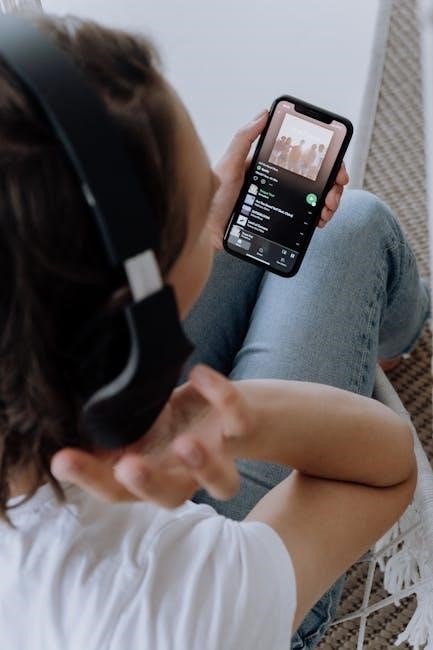Listening guides are structured tools that enhance comprehension and engagement, offering frameworks for effective communication. They provide templates and examples, like PressCable’s press release strategies, to guide focused listening and meaningful interaction in various contexts.
Definition and Purpose of Listening Guides
A listening guide is a structured tool designed to enhance effective communication by providing frameworks for focused listening. Its primary purpose is to help individuals comprehend and engage with auditory content more efficiently. These guides often include templates, examples, and strategies to improve retention and understanding. They are widely used in educational, professional, and personal settings to facilitate meaningful interactions. By offering clear structures, listening guides enable users to identify key points, analyze information, and respond thoughtfully. They also serve as resources for improving communication skills, making them invaluable in diverse contexts, from classrooms to business meetings. PressCable’s press release guide exemplifies such tools, offering practical examples for effective communication.
Importance of Effective Listening in Communication
Effective listening is the cornerstone of successful communication, fostering understanding and collaboration. It ensures that messages are accurately interpreted, reducing misunderstandings and enhancing productivity. In professional settings, such as business meetings or customer service, active listening builds trust and strengthens relationships. Educational environments benefit as students engage more deeply with content, improving learning outcomes. Listening guides play a crucial role by providing structured approaches to capture key details and respond appropriately. Tools like PressCable’s press release templates demonstrate how focused listening can refine communication strategies, ensuring clarity and impact. By prioritizing effective listening, individuals and organizations can achieve their goals more efficiently and build stronger connections.
Types of Listening Guides
Listening guides vary, including structured templates, active listening guides, and customizable examples. They often incorporate strategies like PressCable’s press release templates to enhance engagement and comprehension effectively.
Active Listening Guides
Active listening guides are tools designed to enhance engagement and comprehension during communication. They often include prompts, questions, and strategies to keep listeners focused and attentive. These guides encourage verbal and non-verbal cues, such as nodding or summarizing, to ensure understanding. They are widely used in educational and professional settings to improve retention and participation. For example, PressCable’s press release templates provide structured strategies for crafting effective messages, mirroring the focused approach of active listening guides. By incorporating such techniques, active listening guides help individuals become more mindful and effective communicators, fostering deeper connections and clearer exchanges in various contexts.
Passive Listening Guides
Passive listening guides are tools that allow individuals to absorb information without active engagement. They often involve minimal interaction, focusing instead on silent observation and comprehension. These guides are useful in environments where the listener’s role is to receive information, such as lectures or presentations. They may include note-taking sections or reflection prompts for later use. Unlike active listening, passive listening guides emphasize quiet attention and internal processing. For instance, they can be applied in educational settings where students need to absorb complex material. While less interactive, passive listening guides still aim to enhance understanding and retention, providing a structured approach to processing information effectively.
Selective Listening Guides
Selective listening guides are tools designed to help individuals focus on specific aspects of a conversation or audio content. They often include structured sections that highlight key points or main ideas, allowing listeners to prioritize relevant information. These guides are particularly useful in environments where filtering out distractions is crucial, such as business meetings or educational lectures. By emphasizing selective attention, they enable listeners to concentrate on critical details while ignoring less important elements. For example, they might include prompts to identify action items or key takeaways. This approach enhances productivity and ensures that listeners retain essential information without being overwhelmed by unnecessary details, making them highly effective in both professional and academic settings.

The Structure of a Listening Guide
A listening guide typically includes sections for main ideas, key points, and action items, organized to enhance comprehension. It uses templates and examples, like PressCable’s structured strategies, to focus listening and ensure clear communication.
Key Components of a Listening Guide
A listening guide typically includes main ideas, key points, and action items, organized to enhance comprehension. It uses templates and examples, like PressCable’s structured strategies, to focus listening and ensure clear communication. The guide often outlines objectives, highlights important details, and provides space for notes or reflections. These components help individuals stay engaged and retain information effectively. By incorporating real-world examples, such as press release templates, a listening guide becomes a practical tool for improving understanding and application in various contexts.
How to Create a Listening Guide
Creating a listening guide involves defining its purpose and structure. Start by identifying the context, such as education or business, to tailor the guide’s content. Use templates and examples, like those from PressCable, to ensure clarity and practicality. Include main ideas, key points, and action items, organizing them for easy comprehension. Add sections for notes or reflections to enhance engagement. Keep the design user-friendly and adaptable for different settings. Incorporate real-world examples to demonstrate application. Finally, review and refine the guide to ensure it meets its intended goals and is versatile for various communication styles.
Examples of Listening Guides in Different Contexts
Listening guides are applied in education, business, and media. PressCable’s templates for press releases exemplify their use in professional communication, enhancing clarity and engagement across diverse settings.
Listening Guides for Educational Settings
Listening guides in educational settings are tools that help students engage more effectively with auditory content, such as lectures, podcasts, or discussions. They often include structured templates and examples, like PressCable’s press release guides, which can be adapted for educational purposes. These guides provide clear instructions, key questions, and focal points to enhance comprehension and critical thinking. Educators use them to ensure students stay focused and retain information better. For instance, a listening guide for a history lecture might highlight important dates, concepts, and speaker cues. By tailoring these guides to specific subjects or learning levels, educators can create a more interactive and meaningful learning experience for students.
Listening Guides for Business Meetings
Listening guides for business meetings are tools designed to enhance focus and productivity during discussions. They provide structured frameworks for note-taking, identifying key points, and tracking action items. These guides often include sections for pre-meeting preparation, such as reviewing agendas, and post-meeting follow-ups, like summarizing decisions. By using listening guides, professionals can ensure they capture essential information and stay aligned with meeting objectives. For example, a guide might include prompts to identify the speaker’s main ideas, questions to ask, and areas for clarification. This structured approach helps teams avoid miscommunication and ensures that meetings are productive and goal-oriented, much like how PressCable’s guides streamline press release creation for clarity and impact.

Listening Guides for Podcasts and Audio Content
Listening guides for podcasts and audio content are designed to enhance engagement and comprehension. They often include sections for noting key themes, tracking narrative structures, and identifying main ideas. These guides may also provide prompts for reflection, such as questions to consider or concepts to explore further. For example, a guide might ask listeners to identify the host’s tone or analyze how interviews are conducted. By using these tools, audiences can deepen their understanding and appreciation of the content. Additionally, listening guides can be tailored to specific genres, like true crime or educational podcasts, helping listeners extract maximum value from their audio experiences, much like how structured templates enhance press release effectiveness.

Techniques for Improving Listening Skills
Active listening, verbal cues, and paraphrasing enhance comprehension. Guides like PressCable’s offer structured templates to refine these skills, ensuring clear and effective communication in various professional contexts.
Verbal and Non-Verbal Cues
Verbal cues, such as tone and pitch, convey emotions and emphasize key points, while non-verbal cues like body language and eye contact provide additional context. Guides often highlight these elements to enhance understanding and engagement. For instance, PressCable’s templates include sections for analyzing tone in press releases, helping users grasp the intended message. By recognizing these cues, listeners can better interpret the speaker’s intent, whether in professional settings like business meetings or in creative fields like art exhibitions. Effective use of both verbal and non-verbal cues ensures clear communication and fosters meaningful interactions across various contexts.
Paraphrasing and Summarizing
Paraphrasing and summarizing are essential techniques in listening guides, enabling individuals to grasp and retain information effectively. Paraphrasing involves rephrasing spoken content to ensure understanding, while summarizing captures key points concisely. These methods enhance clarity and focus, particularly in complex discussions. For example, in educational settings, students use these techniques to distill lectures into manageable notes. In business meetings, summarizing decisions and action items ensures alignment. PressCable’s guides, offering structured strategies for press releases, demonstrate how clear communication can be achieved through effective listening and concise summarization. These skills are vital for engaging deeply with content and conveying ideas accurately across various contexts.

Real-World Applications of Listening Guides
Listening guides are widely used in customer service, education, and business to enhance communication. PressCable’s guides, for instance, help craft professional press releases, demonstrating practical applications in marketing and PR.
Listening Guides in Customer Service
Listening guides play a vital role in customer service by ensuring representatives actively engage with clients. They help in identifying key concerns, emotions, and needs through verbal and non-verbal cues. By structuring interactions, these guides enhance empathy and problem-solving skills, leading to better resolutions. For instance, they might include prompts to paraphrase customer statements or ask clarifying questions. This approach fosters trust and satisfaction, turning complaints into positive experiences. Additionally, listening guides enable consistent service quality across teams, ensuring all representatives meet high standards. They also serve as training tools, helping new staff understand effective communication strategies. Ultimately, they bridge gaps between customer expectations and service delivery, creating loyal relationships.
Listening Guides in Therapy and Counseling
Listening guides are essential tools in therapy and counseling, enabling professionals to engage deeply with clients. They provide structured frameworks to capture emotional cues, concerns, and underlying issues; These guides often include sections for note-taking, emotional awareness, and reflection, helping therapists maintain focus and empathy. By using these tools, therapists can better identify patterns, such as recurring themes or unspoken emotions, leading to more effective interventions. Listening guides also promote active listening skills, encouraging therapists to ask insightful questions and validate clients’ experiences. This structured approach enhances therapeutic outcomes, fostering trust and understanding. They are particularly useful for training new therapists, ensuring consistent and compassionate care. Ultimately, listening guides bridge the gap between client expression and therapeutic response, facilitating meaningful healing journeys.
Listening Guides in Public Speaking
Listening guides play a crucial role in public speaking by helping speakers engage audiences effectively. They provide structured frameworks to analyze audience needs, tailor messages, and deliver content clearly. These guides often include sections for audience analysis, key points, and feedback mechanisms. By using listening guides, speakers can ensure their messages are well-received and understood. They also help in identifying non-verbal cues, such as body language, to adapt delivery in real-time. Listening guides encourage active listening, enabling speakers to address questions and concerns promptly. This tool is particularly valuable for crafting persuasive speeches, as it ensures alignment with audience expectations. Ultimately, listening guides enhance the impact of public speaking by fostering connection and understanding between the speaker and the audience.

Tools and Resources for Creating Listening Guides
Customizable templates, structured strategies, and real-world examples from resources like PressCable simplify creating effective listening guides, enhancing clarity and engagement in various communication scenarios.
Templates for Listening Guides
Templates for listening guides provide structured frameworks to enhance comprehension and engagement. They often include sections for key points, questions, and reflections, ensuring focused interaction. Customizable templates, like those from PressCable, offer professional designs and real-world examples, making it easier to create effective guides. These tools are particularly useful in educational and business settings, where clear communication is essential. By using templates, individuals can save time while ensuring their guides are organized and impactful. Examples from PressCable demonstrate how templates can be tailored for specific needs, such as press releases or meeting notes, promoting clarity and consistency in communication strategies.
Software and Apps for Listening Practice
Software and apps designed for listening practice offer interactive tools to enhance auditory skills and comprehension. These platforms provide exercises, audio content, and tracking features to monitor progress. Examples include language learning apps like Duolingo and Babbel, which incorporate listening exercises. Additionally, apps like Otter.ai and Temi offer transcription services, aiding in understanding spoken content. Some tools, such as PressCable’s guides, provide structured templates for creating effective press releases, demonstrating how software can support clear communication. These resources are invaluable for educational and professional settings, helping users refine their listening abilities and apply them in real-world scenarios. By leveraging technology, individuals can improve their listening skills efficiently and effectively.

Cultural Considerations in Listening Guides

Cultural differences significantly impact communication styles, requiring tailored listening guides. PressCable’s guides, for instance, adapt to diverse audiences, ensuring messages resonate effectively across cultural boundaries and enhance understanding.
Cultural Differences in Communication Styles
Cultural differences significantly influence how individuals communicate and interpret messages. In listening guides, understanding these variations is crucial for effective engagement. For instance, some cultures value direct communication, while others prefer indirect approaches. Verbal and non-verbal cues, such as tone, gestures, and eye contact, can vary widely. Listening guides must account for these differences to ensure clear understanding. PressCable’s guides, for example, adapt to diverse communication styles, offering tailored templates that resonate with global audiences. By acknowledging and respecting cultural nuances, listening guides can bridge gaps and foster meaningful interactions across different backgrounds. This adaptability enhances the effectiveness of communication in both personal and professional settings.
Common Mistakes in Listening
Common mistakes include distractions, interrupting, and making assumptions. PressCable’s guides emphasize avoiding these errors, ensuring focused engagement and accurate interpretation of information for effective communication.
Overcoming Distractions

Overcoming distractions is crucial for effective listening. Identify common distractions, such as noise or mental preoccupations, and address them by creating a focused environment. Techniques like active listening and setting clear goals can help maintain concentration. PressCable’s guides emphasize minimizing interruptions and staying engaged, ensuring accurate interpretation of information. By practicing mindfulness and avoiding multitasking, listeners can enhance their ability to absorb and process content effectively. These strategies are particularly valuable in professional settings, such as business meetings or customer interactions, where clear communication is essential. Overcoming distractions not only improves understanding but also fosters respect and efficiency in conversations.
Avoiding Assumptions
Avoiding assumptions is vital for effective communication. Assuming prior knowledge or context can lead to misunderstandings. Listening guides emphasize the importance of clarifying information and asking questions to ensure accuracy. PressCable’s examples highlight the need to approach conversations with an open mind, free from preconceived notions. By actively seeking confirmation and avoiding jumping to conclusions, listeners can gather a more complete understanding. This is particularly important in professional settings, such as customer service or therapy, where accurate comprehension is critical. Avoiding assumptions fosters clearer communication, builds trust, and ensures that the intended message is fully grasped. This approach enhances both personal and professional interactions significantly.
Listening guides are invaluable tools for enhancing communication and understanding. They provide structured frameworks to engage effectively, ensuring clarity and reducing misunderstandings in various professional and personal contexts.

Final Thoughts on the Importance of Listening Guides
Listening guides are essential tools for fostering effective communication and understanding. They provide structured frameworks that enhance engagement, ensuring messages are conveyed clearly and received accurately. By offering templates, examples, and strategies, like those in PressCable’s press release guides, listening guides empower individuals and organizations to communicate professionally and meaningfully. Their adaptability across contexts, from education to business, underscores their universal value. Ultimately, listening guides not only improve comprehension but also strengthen relationships, making them indispensable in both personal and professional settings. Their impact lies in their ability to transform passive hearing into active, purposeful listening, driving clearer interactions and better outcomes.
